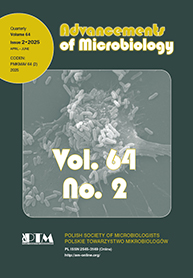1. Introduction. 2. The pathway of cephalosporin C biosynthesis. 3. Secondary metabolism of cephalosporin C. 4. Cellular localization of enzymes involved in cephalosporin C biosynthesis (compartmentalization). 5. Role of peroxisomes in cephalosporin C biosynthesis. 6. Industrial strain improvement. 7. β-lactams in the treatment of various bacterial infections – mode of action. 8. Conclusions
Abstract: Cephalosporin C biosynthesis is a compartmentalized process located mainly in the sub-apical, productive, non-growing cells of the hyphae, which under the conditions of the industrial technology build well-dispersed flocculent mycelia. In this paper, the cephalosporin C production by industrial strains of Acremonium chrysogenum (syn. Cephalosporium acremonium) is described, including the central role of peroxisomes in the biosynthesis and secretion of this antibiotic and other β-lactams. The localization of the pathway of cephalosporin C biosynthesis and important transport steps of intermediates and the end-products are also discussed.
1. Wprowadzenie. 2 Szlak biosyntezy cefalosporyny C. 3. Wtórny metabolizm cefalosporyny C. 4. Lokalizacja enzymów biosyntezy cefalosporyny C w komórkach producenta. 5. Rola peroksysomów w biosyntezie cefalosporyny C. 6. Zwiększanie wydajności szczepów przemysłowych. 7. Rola antybiotykow β-laktamowych w lecznictwie – mechanizm działania antybiotyków β-laktamowych. 8. Wnioski
Streszczenie: W niniejszej pracy omówiono rolę peroksysomów w wytwarzaniu cefalosporyny C przez przemysłowe szczepy A. chrysogenum. Przedstawiono lokalizację enzymów szlaku biosyntezy cefalosporyny C w dojrzałych metabolicznie aktywnych nierosnących komórkach grzybni. Omówiono także niektóre aspekty zwiększania wydajności szczepów przemysłowych.

